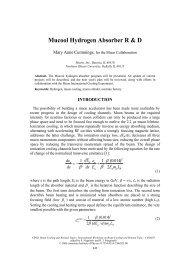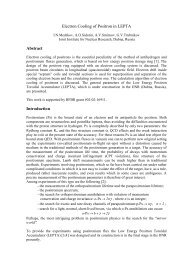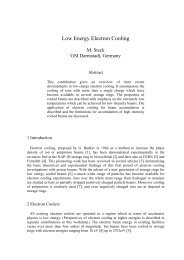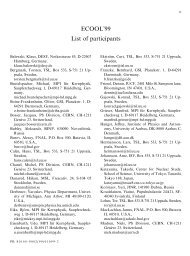Specification of a new electron cooler for the low energy ion ...
Specification of a new electron cooler for the low energy ion ...
Specification of a new electron cooler for the low energy ion ...
You also want an ePaper? Increase the reach of your titles
YUMPU automatically turns print PDFs into web optimized ePapers that Google loves.
402<br />
that <strong>of</strong> <strong>the</strong> injected <strong>ion</strong> beam. Moreover, <strong>the</strong><br />
strong longitudinal magnetic field in <strong>the</strong> gun<br />
would give rise to a large deflect<strong>ion</strong> <strong>of</strong> <strong>the</strong> <strong>ion</strong><br />
beam in <strong>the</strong> toroid reg<strong>ion</strong>, which would require<br />
strong dipoles <strong>for</strong> <strong>the</strong> correct<strong>ion</strong>. The field after<br />
expans<strong>ion</strong> will be 750 G giving an expans<strong>ion</strong> factor<br />
<strong>of</strong> 3 and an orbit deflect<strong>ion</strong> in <strong>the</strong> toroids <strong>of</strong> about<br />
15 mrad. A fur<strong>the</strong>r extens<strong>ion</strong> <strong>of</strong> <strong>the</strong> expans<strong>ion</strong><br />
could be to reduce <strong>the</strong> <strong>electron</strong> beam diameter<br />
during <strong>the</strong> cooling process in order to be at <strong>the</strong><br />
maximum <strong>of</strong> <strong>the</strong> cooling <strong>for</strong>ce always.<br />
In <strong>the</strong> toroidal bend a set <strong>of</strong> electrostatic plates<br />
will be installed in order to improve <strong>the</strong> <strong>electron</strong><br />
beam collect<strong>ion</strong> efficiency. The superimposed<br />
electric and magnetic fields completely compensate<br />
<strong>the</strong> drift that <strong>the</strong> <strong>electron</strong>s usually acquire when<br />
passing through <strong>the</strong> toroid. There<strong>for</strong>e, reflected<br />
and secondary <strong>electron</strong>s will not be lost as <strong>the</strong>y<br />
oscillate between <strong>the</strong> gun and collector, but instead<br />
<strong>the</strong>y will have <strong>the</strong> possibility to be reaccelerated<br />
towards <strong>the</strong> collector. Initial tests made by INP<br />
Novosibirsk [7] show that <strong>the</strong> loss rate DI/I can be<br />
reduced to be<strong>low</strong> 10 5 thus improving <strong>the</strong> vacuum<br />
condit<strong>ion</strong>s in <strong>the</strong> drift sect<strong>ion</strong>.<br />
3.3. The drift sect<strong>ion</strong><br />
The drift sect<strong>ion</strong>, where <strong>the</strong> <strong>electron</strong>s and <strong>ion</strong>s<br />
are merged, will be 2.5 m in length. This is <strong>the</strong><br />
maximum space available <strong>for</strong> cooling after all <strong>the</strong><br />
correct<strong>ion</strong> elements (dipoles and anti-solenoids)<br />
have been inserted into <strong>the</strong> straight sect<strong>ion</strong> where<br />
<strong>the</strong> <strong>cooler</strong> will be installed. Two electrostatic pickups,<br />
capable <strong>of</strong> measuring both <strong>the</strong> <strong>electron</strong> beam<br />
and <strong>ion</strong> beam trajectory in <strong>the</strong> drift sect<strong>ion</strong>, will be<br />
placed at <strong>the</strong> entrance and exit <strong>of</strong> this sect<strong>ion</strong>.<br />
Along with 10 <strong>electron</strong> beam steering coils it will<br />
be possible to perfectly align <strong>the</strong> two beams <strong>for</strong><br />
optimum cooling.<br />
Non-evaporable getter (NEG) strips will be<br />
placed along <strong>the</strong> whole length <strong>of</strong> <strong>the</strong> drift sect<strong>ion</strong><br />
between <strong>the</strong> vacuum chamber and a potential<br />
continuity grid <strong>of</strong> 140 mm diameter. Activated<br />
during <strong>the</strong> bake-out, <strong>the</strong>se NEG pumps will ensure<br />
that <strong>the</strong> vacuum level in <strong>the</strong> cooling sect<strong>ion</strong> is as<br />
<strong>low</strong> as possible during operat<strong>ion</strong>s with <strong>ion</strong> beams.<br />
ARTICLE IN PRESS<br />
G. Tranquille / Nuclear Instruments and Methods in Physics Research A 532 (2004) 399–402<br />
3.4. The <strong>electron</strong> beam collector<br />
Efficient collect<strong>ion</strong> <strong>of</strong> <strong>the</strong> primary <strong>electron</strong> beam<br />
is essential if an excessive load on <strong>the</strong> main highvoltage<br />
power supply is to be avoided. The<br />
collector <strong>for</strong> <strong>the</strong> LEIR <strong>cooler</strong> is designed to collect<br />
<strong>electron</strong>s with relative current losses less than<br />
10 4 . Combined with <strong>the</strong> electrostatic bend (see<br />
Sect<strong>ion</strong> 3.2) <strong>the</strong>se losses can be fur<strong>the</strong>r reduced by<br />
one order <strong>of</strong> magnitude.<br />
4. Conclus<strong>ion</strong>s<br />
The main parameters <strong>of</strong> <strong>the</strong> LEIR <strong>electron</strong><br />
<strong>cooler</strong> have been determined and <strong>the</strong> construct<strong>ion</strong><br />
phase should soon commence. Building on <strong>the</strong><br />
experience <strong>of</strong> our Pb <strong>ion</strong> run in 1997 and recent<br />
developments in <strong>electron</strong> cooling technology, <strong>the</strong><br />
<strong>new</strong> <strong>cooler</strong> should meet <strong>the</strong> requirements <strong>for</strong> <strong>ion</strong><br />
beam cooling and accumulat<strong>ion</strong> <strong>for</strong> <strong>the</strong> LHC. We<br />
will keepa close eye on <strong>the</strong> cooling tests at IMP<br />
Lanzhou [8], expected in 2004, in order to make<br />
final adjustments such that <strong>the</strong> <strong>new</strong> device will be<br />
fully commiss<strong>ion</strong>ed <strong>for</strong> <strong>the</strong> second half <strong>of</strong> 2005<br />
when <strong>the</strong> LEIR machine should come online.<br />
References<br />
[1] M. Chanel, Nucl. Instr. and Meth. A, (2004) <strong>the</strong>se<br />
Proceedings.<br />
[2] J. Bosser, et al., Experimental investigat<strong>ion</strong> <strong>of</strong> <strong>electron</strong><br />
cooling and stacking <strong>of</strong> lead <strong>ion</strong>s in a <strong>low</strong> <strong>energy</strong><br />
accumulat<strong>ion</strong> ring, Particle Accelerators, 63 171, 1999.<br />
[3] G. Tranquille (on behalf <strong>of</strong> <strong>the</strong> AD team), Nucl. Instr. and<br />
Meth. A, (2004) <strong>the</strong>se Proceedings.<br />
[4] J. Bosser, I. Meshkov, G. Tranquille, Magnetised <strong>electron</strong><br />
beam cooling time <strong>for</strong> heavy <strong>ion</strong>s, Internal report CERN/<br />
PS/AR Note 94–11, 1997.<br />
[5] I. Meshkov, A. Sodorin, Nucl. Instr. and Meth. A, (2004)<br />
<strong>the</strong>se Proceedings.<br />
[6] A.V. Ivanov, V.V. Parkhomchuk, B.N. Sukhina, M.A.<br />
Tiunov, The hol<strong>low</strong> <strong>electron</strong> beam. The <strong>new</strong> opportunities<br />
in <strong>electron</strong> cooling, Proceedings <strong>of</strong> <strong>the</strong> Workshopon Beam<br />
Cooling and Related Topics, Bad-Honnef, May 13–18,<br />
2001.<br />
[7] V. Parkhomchuk, private communicat<strong>ion</strong>.<br />
[8] A. Bubley, Nucl. Instr. and Meth. A, (2004) <strong>the</strong>se<br />
Proceedings.








